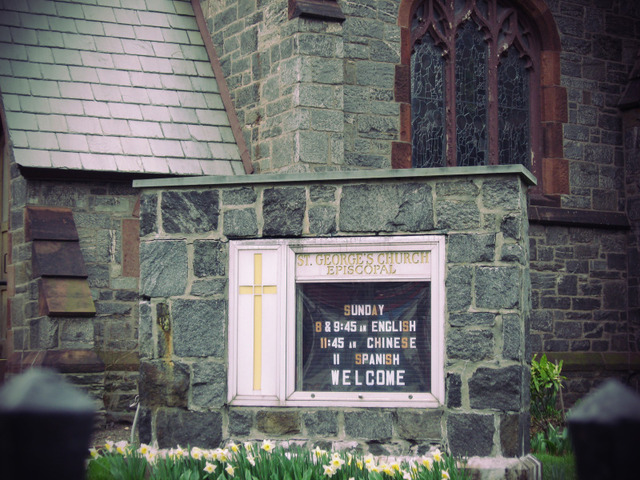From The Peopling of New York City
Contents |
History
The St. George parish, also known as the St. George Episcopal Church, was chartered by King George the Third, ten years before the war for independence. Founded in 1802 by Father George Keith, an ex-Quaker Anglican missionary from the Society for the Propagation of the Gospel in Foreign Parts, from the Church of England. The Church of England was worried about the "nefarious" influence of Quakers on colonists and was thus interested in sending Anglican missionaries to the colonies. Father Keith founded five parishes in Long Island area, three within the current city limits. This church was the principle seat, located in a flourishing town. This church was influential in the formation of the Episcopal Church in the United States, breaking away from the Church of England. Originally the Church's congregation constituted of English people; however, since this church was the only alternative to the Quaker church in the neighborhood, people who were not Anglicans would come to the mass and the church took them in.
With the various waves of immigration coming into New York, the church, willingly and sometimes unwillingly, took in more and more diverse congregations. It began welcoming Dutch and Germans and then, as immigration changed, Eastern Europeans such as Italians and Irish. Yet neither of those groups would become the majority of the church’s future community.
Chinese Immigrants
Starting in the 1950's, Latino immigration to Flushing increased, followed by a heavy Chinese immigration. Many of Chinese coming in to the neighborhood were already Anglicans. Along with the Chinese also came Indian Anglicans. Thus the St. George Episcopal Church in Flushing attracted many of these immigrants. At first, many of the Chinese and Indians that came were English-speaking immigrants, but as immigration to the area increased and changed, more Chinese coming in were not English speaking. The original and older Asian congregation at St. George’s was mainly from Hong Kong, and was composed of primarily Cantonese speakers. In the 1980's, missionaries Father Kwan and Father Shay were hired to get the church more involved in the community and this resulted in newer immigrants joining the church. At this time the immigration from China began to shift from Hong Kong, Cantonese speakers to Mandarin speakers from all parts of China. The church's Chinese congregation has grown exponentially in the past ten years, and most of the new members have been Mandarin-speaking Chinese immigrants. Nowadays the congregation of the Chinese mass is double that of the English and Latino masses combined.
==Latino Immigrants In the 1980's, the Church got involved with the local Latino community. Spanish speaking locals and non-locals would stop by and ask about a Spanish mass, which did not exist at the time. The Church decided to hire a Spanish speaking priest to hold a Sunday evening mass. The Latino community at the church grew and soon requested a midweek mass as well. Father Chase was hired part-time to help out with the growing demand. Currently the church holds three masses in Spanish throughout the week. Through the years the Spanish congregation has fluctuated but in the past five years the Sunday mass attendance has doubled.
Celebrations
The Church hosts many celebrations and events that highlight and celebrate the diverse cultures that surround it. Asian holidays, especially the Lunar New Year, are especially popular with the Church. In addition to ethnic holidays, the church holds immigrant celebrations of American holidays, such as Thanksgiving. Chinese and Latino immigrants, especially, flock to the Church for these major celebrations because they do not have a family tradition of celebrating these holidays. The church also supports cultural religious celebrations, especially Latino Catholic holiday traditions, which shows that St. George's represents not only diverse peoples, but also diverse traditions.
Now and the Church’s Leadership
Currently the majority of the church's community is composed of Asians. At the Church's Annual Parish Meeting, during which the governing body of the church is elected, Chinese, mainly Mandarin speakers, compromised 85% of the attendees. Latinos and other English speaking groups, such as immigrants from the West Indies, Africa, India, Malaysia and South Africa, were in the other 15%.
The Church's governing body, the vestry, is composed of six people. Every year during the Parish meeting, two of the officials are replaced by elections. The first Chinese was elected to the vestry was about twenty five years ago and the first Latino was elected twelve years ago. Formerly, the vestry was composed of two Anglos, two Chinese and two Latinos. After this year's elections, however, there are now three Chinese, one Latino and one Anglo official. The Church expects two more Chinese to be elected next year, and in the future to be entirely Chinese. The Church is worried about the disappearance of Anglo and Latino leadership, who represent immigrants as well, though from a wide variety of places such as the West Indies, Africa, India, Malaysia and South Africa, but acknowledges that the growth of Chinese leadership is inevitable because of the high influx of Chinese parishioners. The church's other officials, its two wardens, also represent the diverse spirit of the church. One is Chinese who is fluent in Fuzhounese, Mandarin, Filipino and English, and the other is a Latino, who also speaks fluently in English and Spanish.
